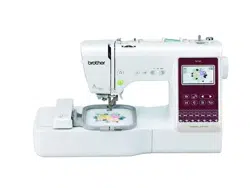Loading ...
Loading ...
Loading ...

Sewing
31
SEWING BASICS
2
Stitch types
1 Utility stitches (page 41)
You can select from utility stitches, including straight line
stitching, overcasting, buttonhole and basic decorative
stitches.
2 Decorative stitches
3 Decorative satin stitches
4 Satin stitches
5 Cross stitch stitches
6 Stitch patterns stored in the machine's memory or USB
flash drive (page 59)
Basic sewing
a
Prepare the appropriate needle and thread for the type
of fabric. (page 27)
If necessary, replace the needle. (page 28)
b
Wind thread onto a bobbin, and then install it into the
machine. (page 19)
c
Thread the upper thread. (page 23)
d
Touch on the operation panel and select the stitch
type.
e
Select a stitch.
displays the previous screen, and displays the
next screen.
• For details on the key functions, refer to “Viewing the
LCD” on page 13.
• If necessary, change to the desired stitch width or
stitch length. (page 35)
f
Check which presser foot is indicated in the upper-left
corner of the screen, and then attach it.
Attach zigzag foot “J” in this procedure. (It is on the
machine when purchased.)
• For details on changing the presser foot, refer to
“Replacing the Presser Foot” on page 29.
Chapter 2
SEWING BASICS
Sewing
CAUTION
• While the machine is in operation, pay special
attention to the needle location. In addition,
keep your hands away from all moving parts
such as the needle and handwheel, otherwise
injuries may occur.
• Do not pull or push the fabric too hard while
sewing, otherwise the needle may break and/
or injuries may occur.
• Never use bent needles. Bent needles can
easily break, possibly resulting in injuries.
• Make sure that the needle does not strike
basting pins, otherwise the needle may break
and cause injury.
1
5
2 3 4 6
Note
• First, perform a trial sewing, using a piece of fabric
and thread that are the same as those used for
your project.
CAUTION
• Always use the correct presser foot. If the
wrong presser foot is used, the needle may
strike the presser foot. The needle may break,
possibly resulting in injury.
Refer to “Stitch Chart” on page 41 for presser
foot recommendations.
Loading ...
Loading ...
Loading ...
